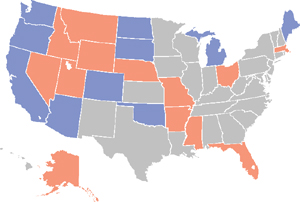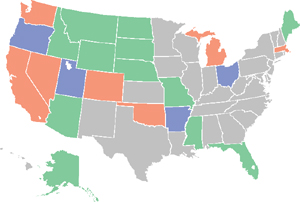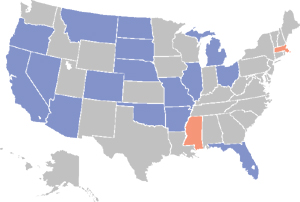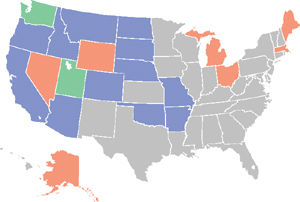Initiative
From dKosopedia
Contents |
Definition
The initiative process gives voters the power to propose and enact legislation by popular vote, rather than through the traditional legislative process. Voters have this power in twenty-four states.
An initiative may be either direct or indirect. In the case of an indirect initiative, the voters must submit legislation to the legislature; if the legislation is not enacted, then it goes to the voters. In the case of a direct initiative, voters may bypass the legislature entirely.
Initiative States
While most initiative states allow voters to propose both laws and amendments, some states permit only one or the other; the maps below show initiative states, whether voters may propose laws, amendments, or both, and whether the initiative may be direct or indirect.
Signature Requirements
Before its sponsors can submit an initiative to the legislature or to the voters of their state, the state requires that its sponsors show proof of popular support. To provide such proof, sponsors circulate petitions in support of the initiative among state residents; if sponsors gather sufficient signatures within a certain time, the initiative will proceed to the legislature or to the voters.
The number of signatures, their geographic distribution, and the time afforded to collect them may vary by state, by year, and by inititiative type. The maps below show whether a state requires signatures follow a certain geographic distribution and how long the state allows signatures to be gathered. The table below further details the signature requirements for each state and initiative type.
| Signature Requirements | |||||||||||||||
| Geographic Distribution | Circulation Period | ||||||||||||||
 |
 |
||||||||||||||
|
|
||||||||||||||
| State | Type | Signatures Required | Geographic Distribution | Circulation Period | |||||||
| AK | IL | 10.0% | of votes cast in the last GE | At least 1 signature in 2/3 of Election Districts | 1 | years | |||||
| AR | DA | 10.0% | of votes cast for Governor | 5.0% | in | 15 | of | 75 | Counties | Unlimited | |
| AR | DL | 8.0% | of votes cast for Governor | 5.0% | in | 15 | of | 75 | Counties | Unlimited | |
| AZ | DA | 15.0% | of votes cast for Governor | No geographic distribution | 20 | months | |||||
| AZ | DL | 10.0% | of votes cast for Governor | No geographic distribution | 20 | months | |||||
| CA | DA | 8.0% | of votes cast for Governor | No geographic distribution | 150 | days | |||||
| CA | DL | 5.0% | of votes cast for Governor | No geographic distribution | 150 | days | |||||
| CO | DA | 5.0% | of votes cast for SOS | No geographic distribution | 6 | months | |||||
| CO | DL | 5.0% | of votes cast for SOS | No geographic distribution | 6 | months | |||||
| FL | DA | 8.0% | of ballots cast in the last PE | 8.0% | in | 12 | of | 23 | Congressional Districts | 4 | years |
| ID | DL | 6.0% | of registered voters | 6.0% | in | 22 | of | 22 | Counties | 18 | months |
| MA | IA | 3.0% | of votes cast for Governor | No more than 25% from a single county | 64 | days | |||||
| MA | IL | 3.5% | of votes cast for Governor | No more than 25% from a single county | 64 | days | |||||
| ME | IL | 10.0% | of votes cast for Governor | No geographic distribution | 1 | years | |||||
| MI | DA | 10.0% | of votes cast for Governor | No geographic distribution | 180 | days | |||||
| MI | IL | 8.0% | of votes cast for Governor | No geographic distribution | 180 | days | |||||
| MO | DA | 8.0% | of votes cast for Governor | 5.0% | in | 6 | of | 9 | Congressional Districts | 16 | months |
| MS | IA | 12.0% | of votes cast for Governor | 20.0% | in | 4 | of | 4 | Congressional Districts | 1 | years |
| MT | DA | 10.0% | of votes cast for Governor | 10.0% | in | 40 | of | 50 | Legislative Districts | 1 | years |
| MT | DL | 5.0% | of votes cast for Governor | 5.0% | in | 34 | of | 50 | Legislative Districts | 1 | years |
| ND | DA | 4.0% | of population | No geographic distribution | 1 | years | |||||
| ND | DL | 2.0% | of population | No geographic distribution | 1 | years | |||||
| NE | DA | 10.0% | of registered voters | 5.0% | in | 38 | of | 93 | Counties | 1 | years |
| NE | DL | 7.0% | of registered voters | 5.0% | in | 38 | of | 93 | Counties | 1 | years |
| NV | DA | 10.0% | of registered voters | 10.0% | in | 13 | of | 17 | Counties | 11 | months |
| NV | IL | 10.0% | of votes cast in the last GE | 10.0% | in | 13 | of | 17 | Counties | 10 | months |
| OH | DA | 10.0% | of votes cast for Governor | 5.0% | in | 44 | of | 88 | Counties | Unlimited | |
| OH | IL | 6.0% | of votes cast for Governor | 1.5% | in | 44 | of | 88 | Counties | Unlimited | |
| OK | DA | 15.0% | of votes cast for Governor | No geographic distribution | 90 | days | |||||
| OK | DL | 8.0% | of votes cast for Governor | No geographic distribution | 90 | days | |||||
| OR | DA | 8.0% | of votes cast for Governor | No geographic distribution | Unlimited | ||||||
| OR | DL | 6.0% | of votes cast for Governor | No geographic distribution | Unlimited | ||||||
| SD | DA | 10.0% | of votes cast for Governor | No geographic distribution | 1 | years | |||||
| SD | DL | 5.0% | of votes cast for Governor | No geographic distribution | 1 | years | |||||
| UT | DL | 10.0% | of votes cast for Governor | 10.0% | in | 20 | of | 29 | Counties | Unlimited | |
| UT | IL | 10.0% | of votes cast for Governor | 10.0% | in | 20 | of | 29 | Counties | Unlimited | |
| WA | DL | 8.0% | of votes cast for Governor | No geographic distribution | 6 | months | |||||
| WA | IL | 8.0% | of votes cast for Governor | No geographic distribution | 10 | months | |||||
| WY | IL | 15.0% | of votes cast in the last GE | 15% of total votes cast in the last election from at least 2/3 of the counties | 18 | months | |||||
Alaska Arizona Arkansas California Colorado District of Columbia Florida Idaho Maine Massachusetts Washington
Timing of Ballot Issues
Only five states permit ballot issues in odd numbered years. They are Maine, Colorado, Mississippi, Ohio and Washington State.
States Without Initiatives
Half of the states (25) do not have the citizen initiative for either constitutional amendments or for laws. They are:
Alabama, Arizona, Connecticut, Delaware, Georgia, Indiana, Iowa, Kansas, Kentucky, Louisiana, Maryland, Minnesota, New Hampshire, New Jersey, New York, North Carolina, Pennsylvania, Rhode Island, South Carolina, Tennessee, Texas, Vermont, Virginia, West Virginia and Wisconsin. Generally speaking, the earlier a state entered the United States, the less likely it is to authorize initiatives.
Criticism
In the late 1800s and early 1900s, when Progressive Era reformers wrote the initiative into state constitutions, they hoped that the process would allow the people and counteract corporate corruption of state legislatures. Unfortunately, the same corporate corruption now influences the initiative process, with corporate interests turning to the initiative when their efforts in the legislature fail.
Critics of the initiative process argue that it leads to bad policy because there is no room to debate or amend a measure -- the citizens must give it an up or down vote as proposed by its sponsor. Critics also argue that voters are often ill informed about initiatives due to a lack of time to study their details or to consider the problems addressed globally (e.g. tax limitations within the context of an overall budget picture).


![[Main Page]](../../../../upload/banner-blue-135.jpg)